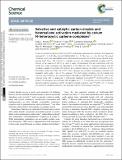Files in this item
Selective and catalytic carbon dioxide and heteroallene activation mediated by cerium N-heterocyclic carbene complexes
Item metadata
| dc.contributor.author | Arnold, Polly L. | |
| dc.contributor.author | Kerr, Ryan W. F. | |
| dc.contributor.author | Weetman, Catherine | |
| dc.contributor.author | Docherty , Scott R. | |
| dc.contributor.author | Rieb, Julia | |
| dc.contributor.author | Cruickshank, Faye L. | |
| dc.contributor.author | Wang, Kai | |
| dc.contributor.author | Jandl, Christian | |
| dc.contributor.author | McMullon, Max W. | |
| dc.contributor.author | Pöthig, Alexander | |
| dc.contributor.author | Kühn, Fritz E. | |
| dc.contributor.author | Smith, Andrew D. | |
| dc.date.accessioned | 2018-10-18T09:30:08Z | |
| dc.date.available | 2018-10-18T09:30:08Z | |
| dc.date.issued | 2018-09-10 | |
| dc.identifier | 256234785 | |
| dc.identifier | be38ef31-38fb-4004-afc9-5125ee79a498 | |
| dc.identifier | 85056096864 | |
| dc.identifier | 000451448000001 | |
| dc.identifier.citation | Arnold , P L , Kerr , R W F , Weetman , C , Docherty , S R , Rieb , J , Cruickshank , F L , Wang , K , Jandl , C , McMullon , M W , Pöthig , A , Kühn , F E & Smith , A D 2018 , ' Selective and catalytic carbon dioxide and heteroallene activation mediated by cerium N-heterocyclic carbene complexes ' , Chemical Science , vol. Advance Article . https://doi.org/10.1039/C8SC03312A | en |
| dc.identifier.issn | 2041-6520 | |
| dc.identifier.other | ORCID: /0000-0002-2104-7313/work/49580162 | |
| dc.identifier.uri | https://hdl.handle.net/10023/16274 | |
| dc.description | We thank the EPSRC for funding through the Centre for Doctoral Training in Critical Resource Catalysis (CRITICAT, EP/L016419/1, R. W. F. K.), EP/J018139/1 and the UK Catalysis Hub (EP/K014714/1, P. L. A., C. W.), EP/M010554/1 (P. L. A.). This project has received funding from the European Research Council (ERC) under the European Union's Horizon 2020 research and innovation programme (grant agreement No. 740311, P. L. A.). K. W. thanks the China Scholarship Council (CSC) for a postgraduate fellowship. P. L. A., M. W. M., J. R. and F. E. K. thank the Technische Universität München – Institute for Advanced Study, funded by the German Excellence Initiative. A. D. S. thanks the Royal Society for a Wolfson Research Merit Award. C. J. thanks the DAAD for a scholarship, and C. J. and J. R. thank the TUM Graduate School for financial support. | en |
| dc.description.abstract | A series of rare earth complexes of the form Ln(LR)3 supported by bidentate ortho-aryloxide–NHC ligands are reported (LR = 2-O-3,5-tBu2-C6H2(1-C{N(CH)2N(R)})); R = iPr, tBu, Mes; Ln = Ce, Sm, Eu). The cerium complexes cleanly and quantitatively insert carbon dioxide exclusively into all three cerium carbene bonds, forming Ce(LR·CO2)3. The insertion is reversible only for the mesityl-substituted complex Ce(LMes)3. Analysis of the capacity of Ce(LR)3 to insert a range of heteroallenes that are isoelectronic with CO2 reveals the solvent and ligand size dependence of the selectivity. This is important because only the complexes capable of reversible CO2-insertion are competent catalysts for catalytic conversions of CO2. Preliminary studies show that only Ce(LMes·CO2)3 catalyses the formation of propylene carbonate from propylene oxide under 1 atm of CO2 pressure. The mono-ligand complexes can be isolated from reactions using LiCe(NiPr2)4 as a starting material; LiBr adducts [Ce(LR)(NiPr2)Br·LiBr(THF)]2 (R = Me, iPr) are reported, along with a hexanuclear N-heterocyclic dicarbene [Li2Ce3(OArCMe–H)3(NiPr2)5(THF)2]2 by-product. The analogous para-aryloxide–NHC proligand (p-LMes = 4-O-2,6-tBu2-C6H2(1-C{N(CH)2NMes}))) has been made for comparison, but the rare earth tris-ligand complexes Ln(p-LMes)3(THF)2 (Ln = Y, Ce) are too reactive for straightforward Lewis pair separated chemistry to be usefully carried out. | |
| dc.format.extent | 11 | |
| dc.format.extent | 2680640 | |
| dc.language.iso | eng | |
| dc.relation.ispartof | Chemical Science | en |
| dc.subject | QD Chemistry | en |
| dc.subject | DAS | en |
| dc.subject.lcc | QD | en |
| dc.title | Selective and catalytic carbon dioxide and heteroallene activation mediated by cerium N-heterocyclic carbene complexes | en |
| dc.type | Journal article | en |
| dc.contributor.sponsor | EPSRC | en |
| dc.contributor.sponsor | EPSRC | en |
| dc.contributor.sponsor | EPSRC | en |
| dc.contributor.sponsor | The Royal Society | en |
| dc.contributor.institution | University of St Andrews. EaSTCHEM | en |
| dc.contributor.institution | University of St Andrews. School of Chemistry | en |
| dc.contributor.institution | University of St Andrews. Biomedical Sciences Research Complex | en |
| dc.identifier.doi | 10.1039/C8SC03312A | |
| dc.description.status | Peer reviewed | en |
| dc.identifier.grantnumber | EP/J018139/1 | en |
| dc.identifier.grantnumber | EP/L016419/1 | en |
| dc.identifier.grantnumber | EP/J018139/1 | en |
| dc.identifier.grantnumber | WM140071 | en |
This item appears in the following Collection(s)
Items in the St Andrews Research Repository are protected by copyright, with all rights reserved, unless otherwise indicated.

